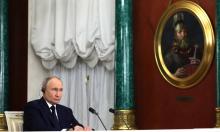Russia, USA signed START II 10 years ago
Presidents Boris Yeltsin of Russia and George Bush, Sr., of the USA signed the START II, treaty on further reductions and limitations of offensive arms, in Moscow, ten years ago this day-January 3, 1993.
The treaty developed on the premises of the START I to more drastically reduce the threat of using nuclear arms by envisaging greater cuts on deployed strategic offensive forces to 3,000-3,500 warheads for each Party. It introduced new regulations to evaluate the signatory countries' potentials proceeding from the number of nuclear warheads, rather than vehicles, and put an end to a dual arrangement of counting nuclear warheads carried by heavy bombers.
The treaty included:
a protocol on liquidation or conversion, which concerned IBMs and heavy IBM silos;
a protocol on demonstration and verification, concerning heavy bombers; and a memorandum on attribution.
It was initially envisaged to implement the START II in two stages. Strategic offensive forces deployed by either Party were to possess no more than 3,500 warheads each by January 1, 2003-a ceiling 1,750 of these to be based on submarines. The signatories were to give up MIRVs and heavy IBMs, and each pledged to possess up to a hundred heavy bombers re-equipped for non-nuclear missions and not to be accounted for within treaty limits.
The US Congress ratified the START II, January 26, 1996.
The Russian and US Presidents signed a joint statement in Helsinki, March 1997, which put off the liquidation deadline on START II to December 31, 2007.
Evgeni Primakov, then Russia's Minister of Foreign Affairs, and Madeleine Albright, US Secretary of State, signed a protocol to the START II, in New York City, September 26, 1997. The document, which became part and parcel of the treaty, envisaged the related strategic offensive arsenal reduction deadline postponed for five years to December 31, 2007.
The State Duma, the Russian parliament's lower house, ratified the START II, the ABM treaty of 1972, with the 1997 protocol, and the CTBT-comprehensive nuclear test ban treaty-on April 14, 2000. With that, Russia pledged to reduce the number of its nuclear warheads to 3,500 before 2007, not to establish strategic ABM defences, and not to make whatever nuclear tests. Russia secured its right to comply with the treaty only in case the US Congress finished the START II ratification procedure, complete with a related protocol-as signed in New York City, September 26, 1997; a memorandum on a related understanding; two mutually coordinated statements on the ABM treaty; and an agreement on confidence-building measures concerning defence from non-strategic ballistic missiles.
Russia secured the right to leave the START II in an extraordinary situation-in particular, in case the USA quit the ABM treaty, deployed an NMD system, violated the START II, or deployed nuclear arsenals in countries newly admitted to NATO-and in other situations which might endanger Russia's national security.
The Federation Council-the Russian parliament's upper house-approved the START II in a landslide vote of April 19, 2000.
Vladimir Putin, then Russia's acting President, signed a law to ratify the START II, May 4, 2000.
Russia was counting on the USA to make a similar constructive choice and finish treaty ratification. However, the USA banged the door on the 1972 ABM treaty, June 13, 2002, to invalidate an international legal instrument which had been a cornerstone of strategic stability for thirty years. The USA refused to ratify the START II and the New York City understandings.
Proceeding from the US moves and the premises of its own federal law on START II ratification, Russia officially announced that it was leaving the START II, June 14, 2002.
Subscribe to Pravda.Ru Telegram channel, Facebook, RSS!





